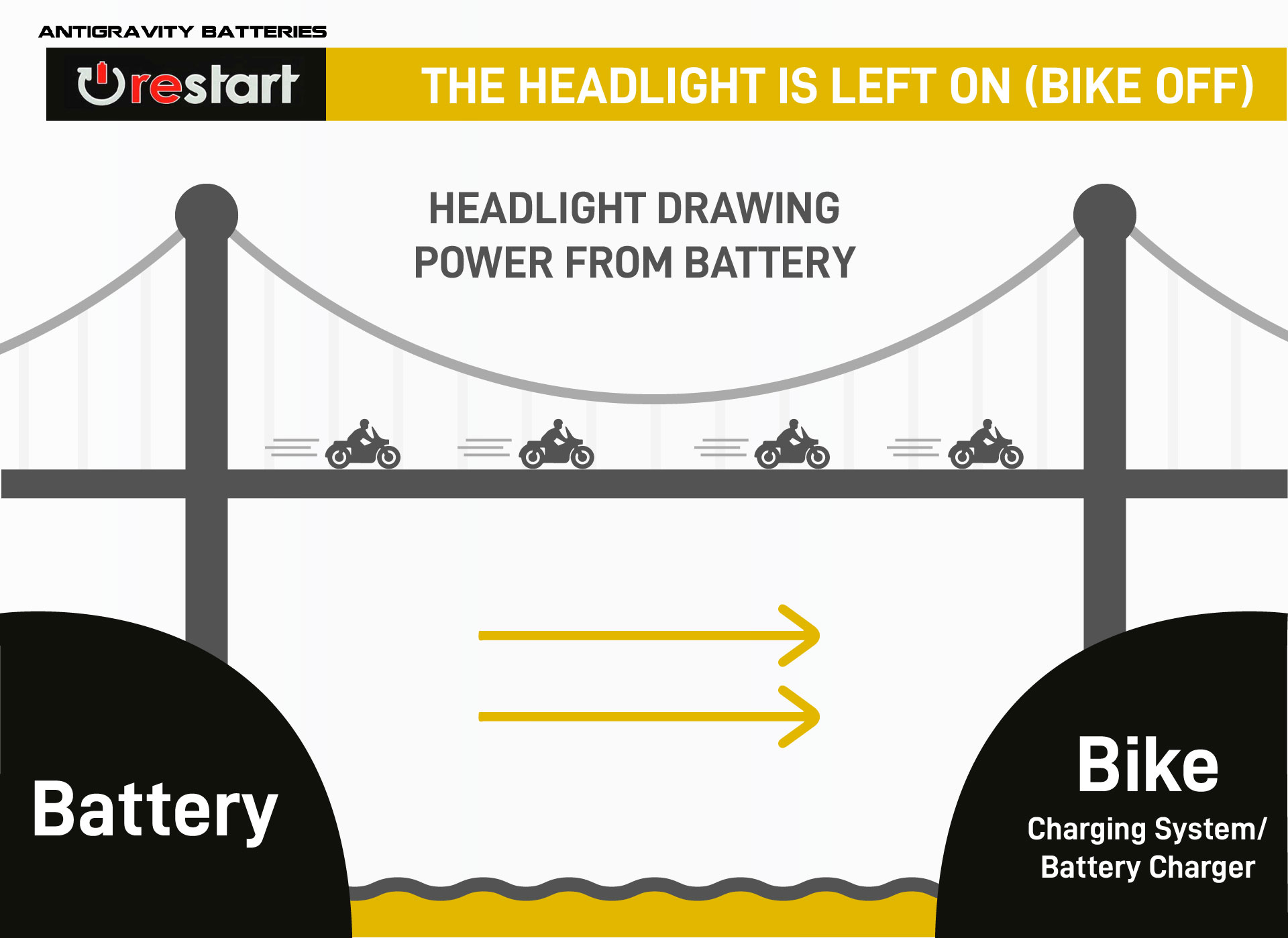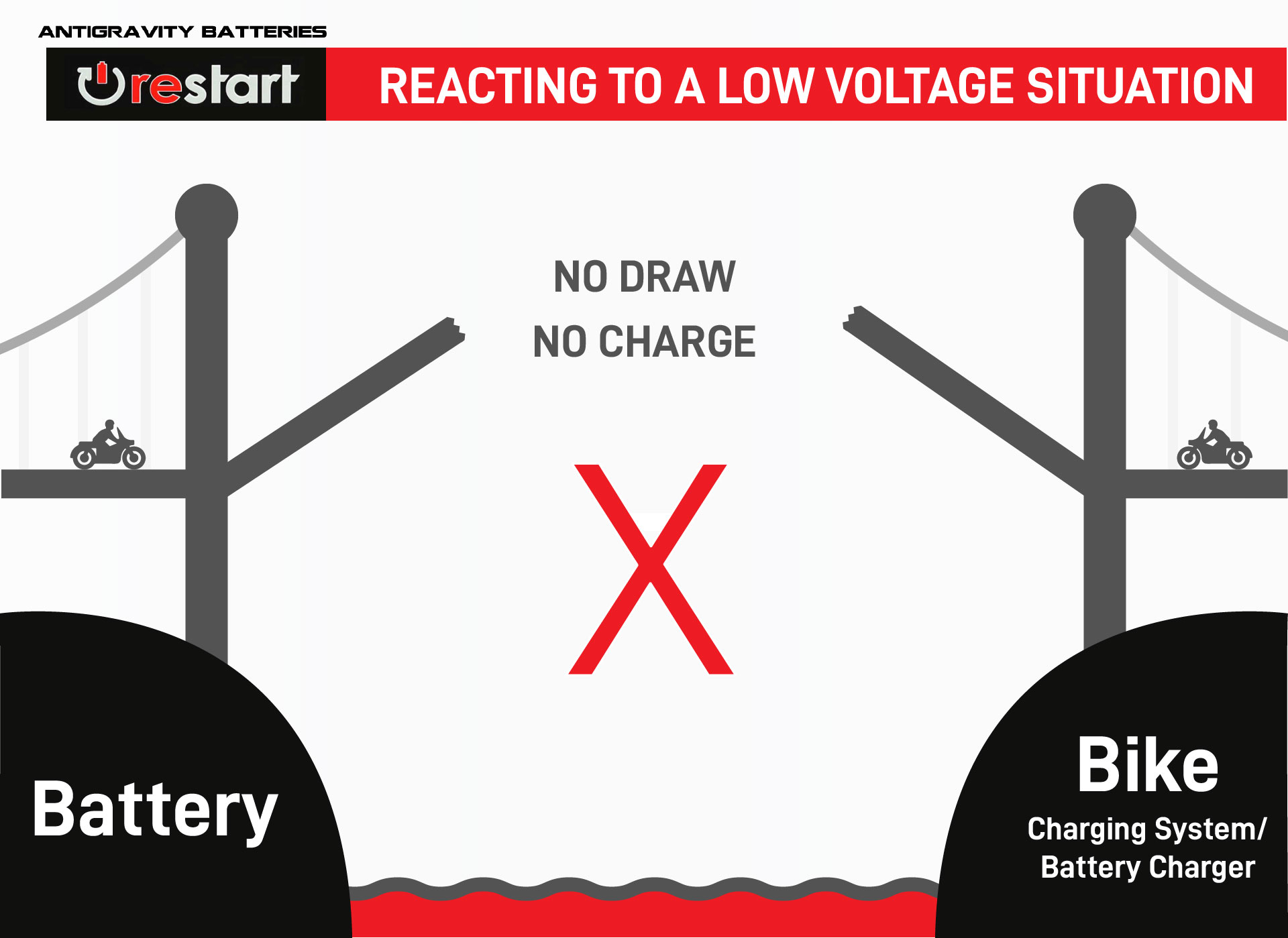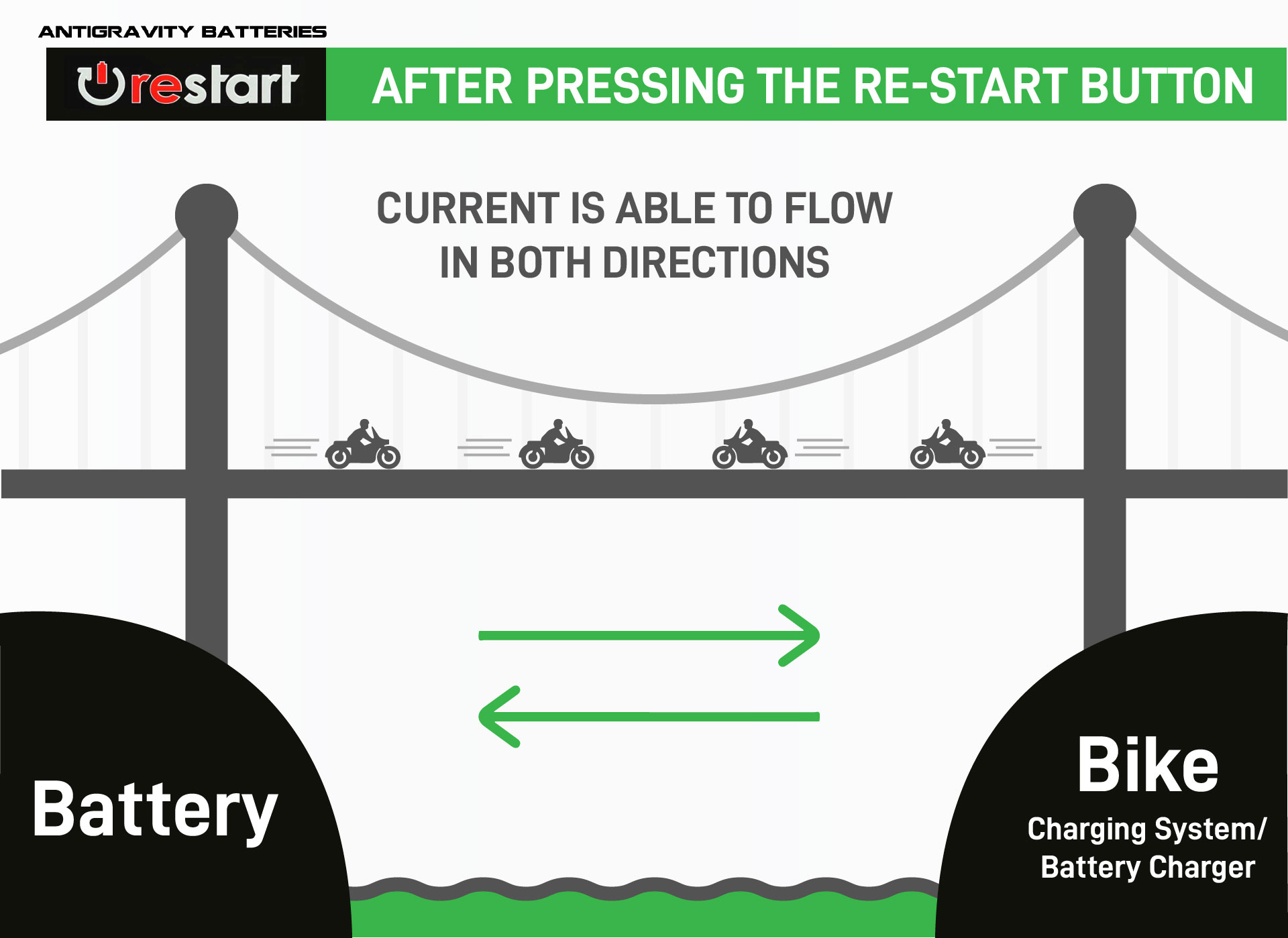How to Use the Antigravity Batteries® Re-Start™ Button
Posted by Dan Doyle on 6th Feb 2020
The problem we hear from many customers: “I can’t seem to charge my new Re-StartTM battery. It either stops charging altogether or goes into safe mode…”
This blog will cover the issues faced when trying to charge an Antigravity Batteries® Re-StartTM battery with an OptiMate® charger and other lithium chargers. Let me just start by saying that the problem usually isn’t the charger OR the battery. It’s the perfect storm of technology built into each device that when the two are put together creates a bit of confusion for the end user if they haven’t had experience with this type of battery. Just read on and it’ll all make sense.
First I’ll explain what the Re-StartTM function does by using a drawbridge as an analogy.
- The drawbridge represents the Re-StartTM function that “bridges” the gap between the battery and your bike (which is really the charging system, or in this case, the charger.)
- The motorcycles on the bridge represent current (moving in either direction.)
- Motorcycles crossing the bridge from your battery to the bike represent a draw on the battery.
- Motorcycles crossing the bridge from your bike to the battery represent a charge from your charger OR the charging system.
- When the draw bridge is closed, motorcycles can pass from one side to the other.
- When the draw bridge is open, motorcycles cannot pass from either direction.
The Re-StartTM function is like the bridge opening up and stopping the oncoming road traffic. It cuts off the flow of the motorcycle, or current, from your battery to whatever is drawing current from your battery. This happens once the voltage reaches a certain low-level. Once that happens, all you have to do is press the Re-StartTM button on top of the battery and the bridge will close allowing motorcycles (current) to flow freely again. This way you’re left with enough reserve to start up your bike to allow the charging system to charge your battery. That’s how the Re-StartTM function works in simple terms.
This function is great as it keeps you from being stranded if you leave your headlight on or have issues with parasitic draw from a bad ground, GPS, alarm or other current drawing features.
Here are three separate graphics which will help to better illustrate the Re-StartTM function in action.
In the first frame, you have a situation where you have left your headlight on. The bike is off, so the charging system isn’t there to provide power, which means it’s up to the battery to power headlight, slowly using up its reserve.

As you can see, the bikes are all riding in one direction because the headlight is drawing power directly from the battery.
At some point (assuming you’re not using a charger), your battery will reach a “low voltage” level and the Re-StartTM function will “kick in” effectively cutting off the flow of current. No, more draw on your battery. The headlight shuts off because at this point the battery is essentially “cut-off” from the bike altogether. You go to start your bike the next day aaaaaand nothing. You have what feels like a “dead” battery.

Now that the draw bridge is open, no more bikes can ride from the battery to the bike, which means no more draw. But, now bikes can’t ride towards the battery either, meaning that the bike has no power and battery is cut-off from being able to accept a charge.
All you need to do is press the Re-StartTM button and the battery will “re-engage” allowing the flow of current in either direction, which means that you can now start the bike with the battery’s reserve power.

Current can now flow freely in either direction allowing you to start the bike or throw the battery on a charger.
If what is left in the reserve isn’t enough to start the bike, you will need to hook the battery up to a lithium charger which you can buy here on our site. This can be the result of a few different scenarios:
- Perhaps the bike suffers from parasitic draw and the Re-StartTM function kicks in cutting off the draw. But then the bike sits in storage for months on end with no charger allowing the battery to lose even more of its capacity simply by sitting unattended. This is called self-discharge.
- The Re-StartTM function kicks in and you attempt, but fail, to start the bike a few times, you are now far below the low-voltage point.
So you hook up your charger and after a bit, the charger cuts off or goes into “save” mode.
The reason being is that the battery senses that the voltage is STILL at a low-level and the Re-StartTM function kicks in once again, opening the draw bridge, cutting off the battery from being able to accept a charge.
The only safe fix for now is to hit the Re-StartTM button every time the Re-StartTM function kicks in. Eventually the battery’s voltage level will rise above the “low level” point and the Re-Start function will no longer kick-in allowing the charger to continue charging as it normally would.
It’s not the end of the world, but it can be frustrating if you have no idea why your fancy new lithium battery isn’t taking a charge.
If you have a larger capacity battery, use a charger with a higher amp output.
For example, if you have a larger capacity battery and you’re using a charger that is only putting out a max of .8 amps per hour (TM-471), there is a good chance that you’re going to have hit the Re-StartTM button a bunch of times before the battery is above the low-voltage level. This is why we recommend the 5 amp/hour charger from OptiMate® (TM-291) if you have a larger capacity battery. Although you might run into the same issue, at a max of 5 amps per hour, you will only have to press the Re-StartTM button a couple of times before the battery is above the low-level point.
Please note that there are a bunch of different charger options out there offering different levels of performance at very different price points. I know you just spent more than you wanted to on that lithium battery, but that is why you don’t want to cheap out on the charger that is keeping it working properly. We recommend OptiMate® as they have taken the time to deliver a quality charger at an affordable price. They have the tech to not only automatically maintain a lithium battery, but their chargers are also capable to safely recover a low-voltage lithium battery. This is an extremely important feature that is often over looked when it comes to other brands chargers.
If you’re not sure which charger to get for your lithium battery, check out our blog about choosing a lithium charger here.





